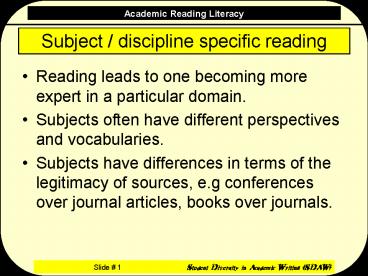Subject discipline specific reading - PowerPoint PPT Presentation
1 / 16
Title:
Subject discipline specific reading
Description:
Skim read. Main purpose ... Skim read the extensions. What do you think this is about? Where ... the items to skim read, and a different one to read in depth, ... – PowerPoint PPT presentation
Number of Views:54
Avg rating:3.0/5.0
Title: Subject discipline specific reading
1
Subject / discipline specific reading
- Reading leads to one becoming more expert in a
particular domain. - Subjects often have different perspectives and
vocabularies. - Subjects have differences in terms of the
legitimacy of sources, e.g conferences over
journal articles, books over journals.
2
Week 2 ACADEMIC READINGManaging, engaging
with and recording what you read
- LING 402 - ACADEMIC DISCOURSE PRACTICES A
critical approach
3
Different ways of reading
4
Different ways of reading
5
Different ways of reading
Intensive
6
Different ways of reading
Extensive
Intensive
7
Different ways of reading
NOT ALL LIKE THIS!
Extensive
Intensive
8
Reading Strategies
All academic reading has a focus and a purpose
9
Reading depth
- Scan read
- Main purpose is to gain overall impression.
Reading for relevance, key words and to determine
quality/legitimacy. - Skim read
- Main purpose is exploratory. Reading for key
words, vocabulary, key arguments (schools of
thought) - In-Depth read
- Main purpose is reflexive or critical reading
10
Active reading
- Reading is an active process in which the reader
continually anticipates the meaning of the text - Speed reading as a form of active reading
- Reading is an active process in which the reader
continually anticipates the meaning of the text
(7 out of 16 words)
11
Scan read the periphery
12
Academic Reading Exercise 3
- Scan read a number of academic journal papers and
a number of academic books (from one of your
course reading lists) - Make some notes
- What was difficult about it?
- What did you learn from the experience?
- If possible discuss it in a group
13
Skim read the extensions
14
Read the core in-depth
15
INDIVIDUAL WORK
- Look at your reading list. Mark items as core,
extension or peripheral - Scan read all three items you brought with you,
using the notes on slide 10. - Choose one of the items to skim read, and a
different one to read in depth, - Use these to practice skim-reading and reading
in-depth using the notes on slides 12 and 14
(just a page or two, there isnt time to read the
whole paper) - Discuss
- What was difficult about it?
- What did you learn from the experience?
- How can this help you to manage and engage with
your course reading?
SMALL GROUP WORK
16
Concluding comments
- Important to
- Identify and reflect upon existing experience
- Practice those aspects of academic reading
literacy that you are not familiar with - This is an ongoing process as you become more
expert in a subject area. - Practice, practice, practice.

